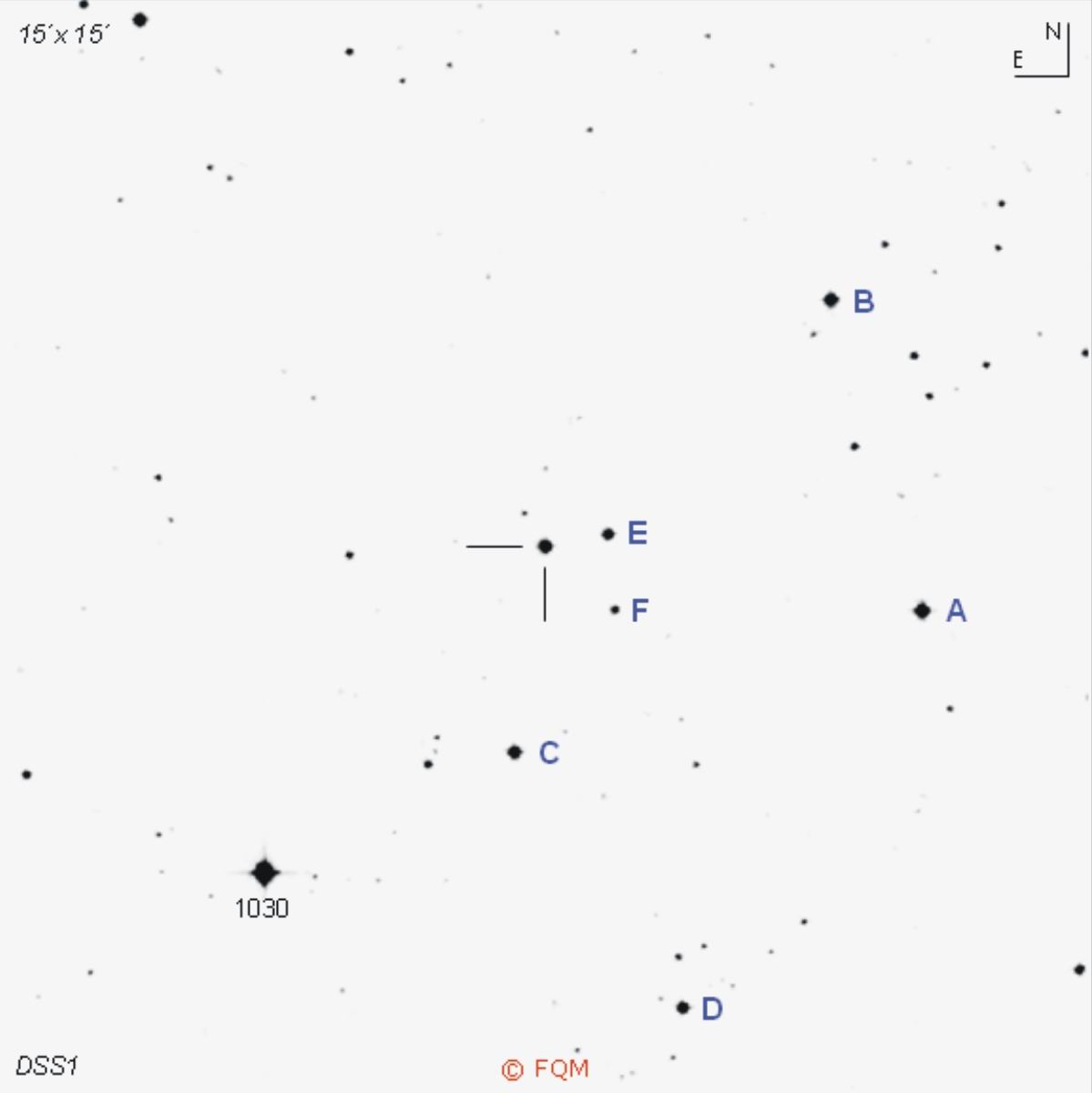
| Frankfurt Quasar Monitoring |
| 3C 273 |
| Cross-Identifications |
4C +02.32, PG 1226+023, ON+044, 1226+023 MSH 12+08, NRAO 400, PGC 41121, RBS 1114 PKS 1226+02, HE 1226+0219, 1ES 1226+023 RX J1229.1+0203, 2EG J1229+0206, DA 324 2MASX J12290674+0203083, TXS 1226+023 1FGL J1229.1+0203, SWIFT J1229.1+0202 GALEXASC J122906.80+020308.2, CTA 53 WMAP J1229+0203, IRAS 12265+0219 |
| Equat. coordinates | RA 12 29 06.7 DE +02 03 08 (J2000) |
| Constellation | Virgo |
| Type | QSO |
|
Redshift
|
z=0.158 |
|
Distance
(2)
(3) |
633
Mpc |
| Total mag range (mv) (4) (5) | 12.0 - 13.3 |
| Catalog Magnitude (1) | 12.85 |
| Absolute Magnitude (1) | -26.9 MB |
| Light Travel-Time (2) | 1.918 × 109 yrs |

Comparison stars
| star | B | V | Rc |
| A | 12.85 | 11.87 | 11.30 |
| B | 13.17 | 12.68 | 12.31 |
| C | 13.33 | 12.69 | 12.27 |
| D | 14.03 | 12.93 | 12.34 |
| E | 14.12 | 13.56 | 13.16 |
| F | 16.04 | 14.94 | --- |

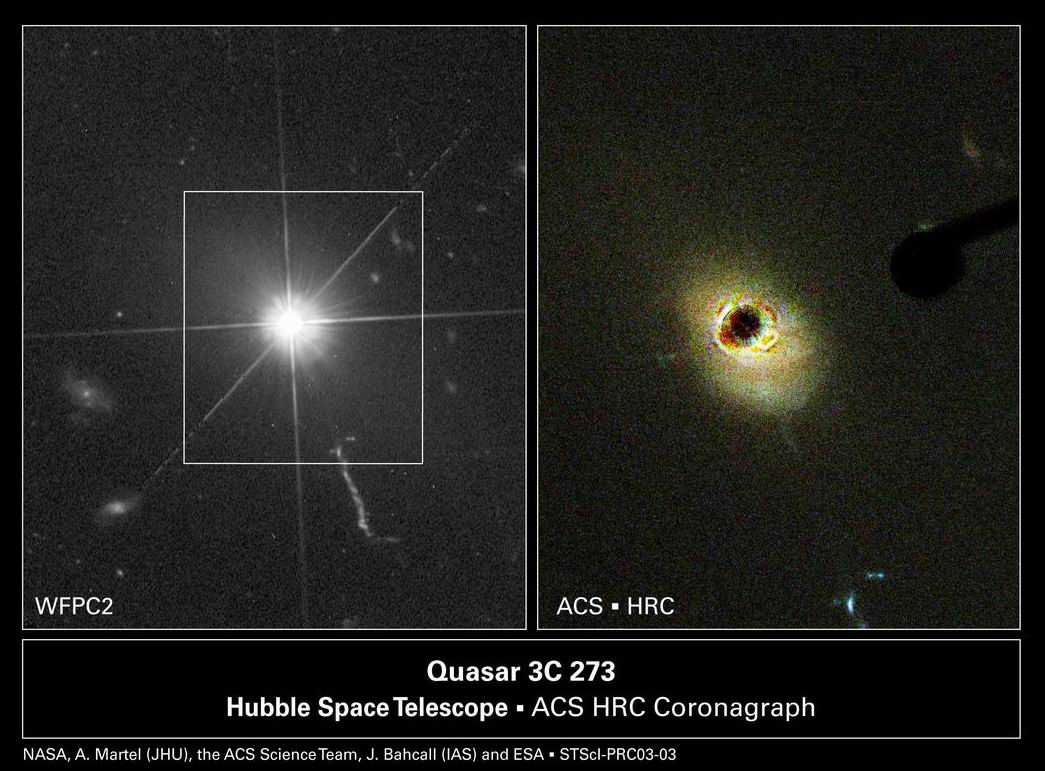
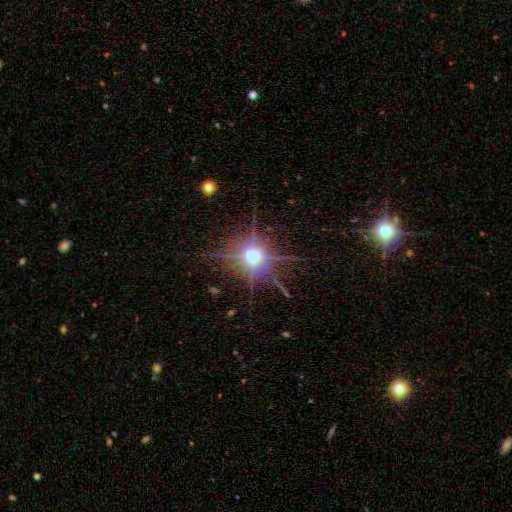 Credit:
SDSS / Size: 3´× 3´ | 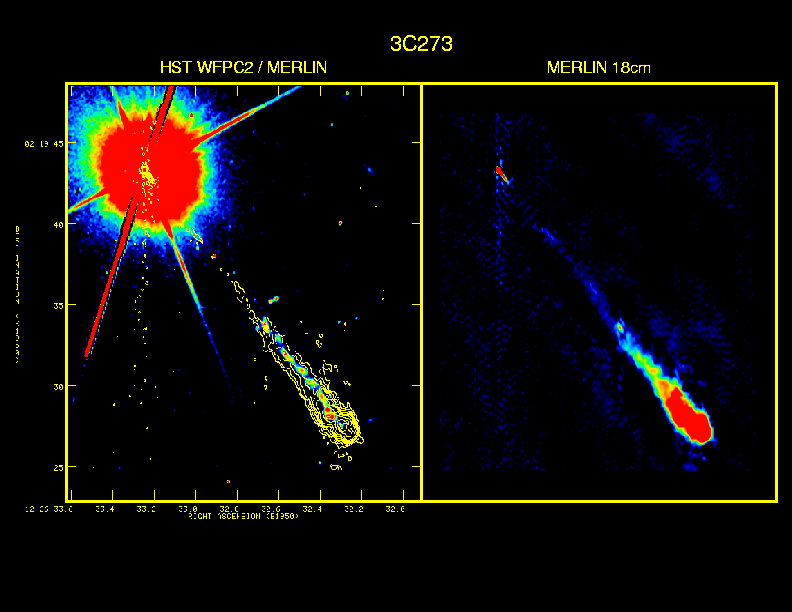 Credit:
Hubble Space Telescope (WFPC2) / MERLIN |
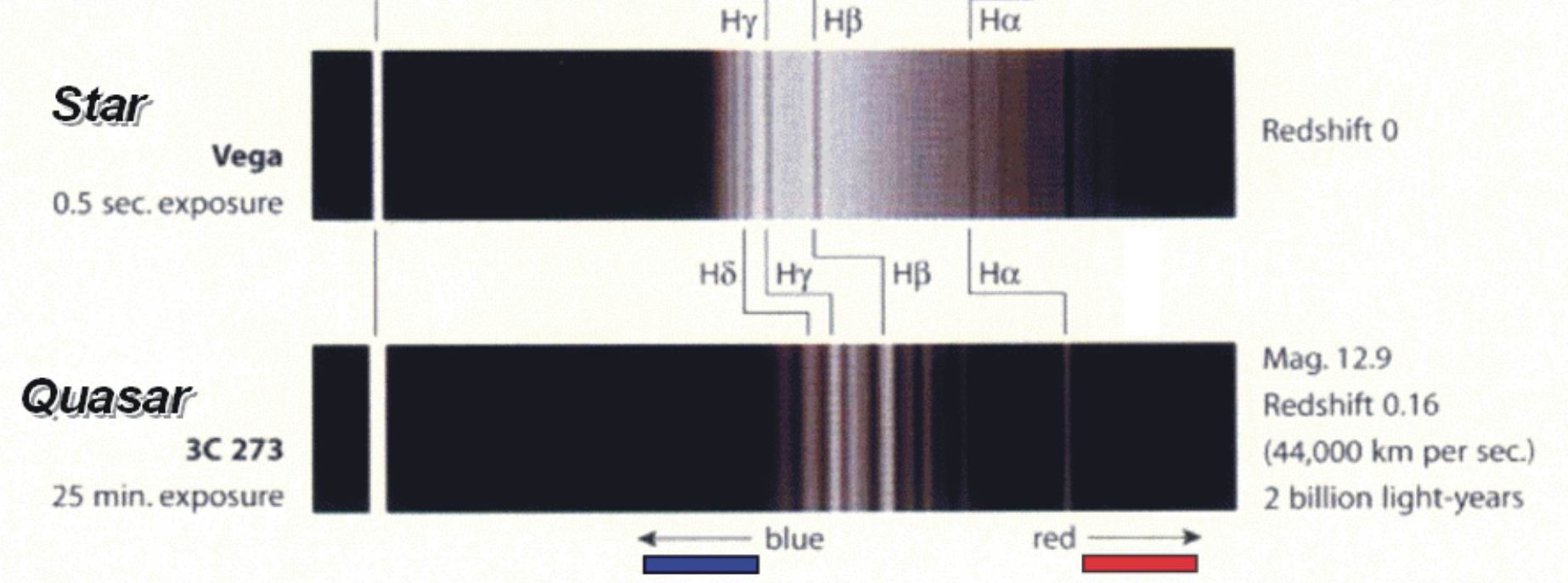
| 3C
273 is the brightest quasar in the heavens, and consequently a very
famous object in astrophysics. At a distance of about 2×109
light-years, 3C 273 is located in the far cosmological background of
the southern extension of the Virgo galaxy cluster. It is very bright
across all wave bands from radio to gamma. Quasar 3C 273
was discovered in 1959 as a radio source by the 3. Cambridge Radio
Survey (3C). Since then, this quasar has been cataloged by several
other radio surveys (e.g. 4C, PKS, MG). Spectroscopic investigations of
the stellar
optical
counterpart
revealed a Seyfert 1-spectrum. In 1963, Maarten Schmidt first deciphered its spectral redshift. The position of the quasar spectral lines did not fit with those known from the absorption line pattern of ordinary stars. Schmidt identified the true nature by shifting the emission line pattern to the red end of the spectrum (see image above). In fact, the expansion of the universe shifted the spectral lines by 15.8 per cent (z=0.158). The host galaxy of 3C 273 is an elliptical galaxy (see image above). One of the most striking features of 3C:273 is a single jet, emerging from the galactic centre - extending 23" to the SW. Structures and changes inside the jet have been well studied through all wavelengths. New investigations on the central black-hole of 3C 273 was undertaken by ESO´s Very Large Telescope GRAVITY Collaboration, which were published in 11/2018. As the result, the supermassive black-hole has an inferred mass of about 300 million solar masses (2.6 ± 1.1 ×108 MSo). In addition, the radius of the accretion disk was determined as 150 ± 40 light days, or 0.13 pc. 3C 273 is a low amplitude variable object ranging between 12m.0 - 13m.2! No question, 3C 273 is a must for all observers! CCD photometrists, as well as visual observers, shall use the comparison stars given above. Other photometric sequences were published by Doroshenko et al. (2005), Fiorucci et al. (1998), Gonzŕlez-Pérez et al. (2001), Hamuy et al. (1989) and Sutton et al. (1974) - which underlines the high astrophysical significance for this quasar-"superstar". Visual observers need at least a 6-inch telescope to glimpse this famous stellar object in the eyepiece. 3C 273 is the only quasar that found entry into observing handbooks and star charts. ____________
Two
bright 11-mag spirals can be found
about 1.4° E of 3C 273: NGC
4536 and NGC
4527. Both galaxies are type SBbc-spirals and members of the
Virgo
galaxy cluster. Another quasi-stellar object, 14-mag quasar RX J1230.8+0115, can be found only 1° SE of 3C 273. So when you are around for 3C 273, why not taking a look at quasar RX J1230.8+0115 as well? |
| Angione, R.J., Smith,
H.J. 1985, AJ, 86, 653; 3C 273 Historical Data Base. Boroson, T.A., Green, R.F. 1992, ApJS, 80, 109; The Emission-Line Properties of Low-Redshift Quasi-Stellar Objects. Corso, G.J., Ringwald, F., Schultz, J. 1988, PASP, 100, 70; Blue-Light Monitoring of 3C 273, 3C 351, 3C 454.3, 3C 66A, PKS 2141+17, OJ 287 and ZE 0039.5+04. Courvoisier, T.J.-L., Robson, E. 1991, Spektrum der Wissenschaften 8/91, 94; Der Quasar 3C 273. Craine, R.E.; A Handbook of Quasistellar and BL Lacertae Objects; Parchart Publishing House, Tuscon 1977. Disney, M. 1998, Spektrum der Wissenschaft 8/98, 40; Quasare: die kosmischen Mahlströme. Fiorucci, M., Tosti, G. 1996, A&AS, 117, 475; Automatic optical Monitoring of 10 Blazars. Giveon, U., Maoz, D., et al. 1999, MNRAS, 306, 637G; Long-term optical Variability Properties of the Palomar-Green Quasars. GRAVITY collaboration: Sturm, E., Dexter, J., Pfuhl, O., Stock, M.R., et al. 2018, Nature 563, 657-660; Spatially resolved ordered rotation of a quasar broad line region at sub-parsec scale. Greenstein, J., Schmidt, M. 1964, ApJ, 140, 1; The Quasi-Stellar Radio Sources 3C 48 and 3C 273. Grueff, G., Vigotti, M. 1979, A&AS, 35, 371; Optical Identification and 5GHz Flux Measurements of Radiosources selected from the B2 Catalogue - V. Hansen, T. 1991, Deep Sky Magazine 34, 32; The "Deepest" Deep Sky Objects. Harrington, P. 1994, Astronomy 6/94, 56; Tracking down a Quasar. Karge, S.; Helle Quasare für 8- bis 10-Zoll Teleskope. Ein Beobachtungsführer zur visuellen Beobachtung von Quasaren und BL Lacertae Objekten; Frankfurt 2005. Katajainen, S., Takalo, L.O., et al. 2000, A&AS, 143, 357; Tuorla Quasar Monitoring. I. Observations of 1995-1997. Lloyd, C. 1984, MNRAS, 209, 697; Optical Monitoring of Radio Sources. Penston, M.J., Penston, M.V., et al. 1971, PASP, 83, 783; Stars observed photoelectrically near Quasars and Related Objects. Puetter, R.C., Smith, H.E., et al. 1978, ApJ, 226, L53; Spectrophotometry of Quasi-Stellar Objects at Optical and Infrared Wavelengths: PG 0026+129 and 3C 273. Rösner, H.J. 1989, SuW 7-8/89, 414; Der Quasar 3C 273 und seine Muttergalaxie. Rösner, H.J., Meisenheimer, K. 1991, A&A, 252, 458; The Synchrotron Light from the Jet of 3C 273. Sandage, A. 1964, ApJ, 139, 416; Intensity Variations of 3C 48, 3C 196 and 3C 273 in optical Wavelengths. Schmidt, M., Green, R.F. 1983, ApJ, 269, 352; Quasar Evolution derived from the Palomar Bright Quasar Survey and other complete Quasar Surveys. Sillanpää, A., Haarala, S., et al. 1988, A&AS, 72, 347; Optical Monitoring of Quasars and BL Lac Objects. Smith, P.S., Balonek, T.J., et al. 1985, AJ, 90, 1184; UBVRI Field Comparison Stars for selected Active Quasars and BL Lacertae Objects. Spevak, J. 1994, Astronomy 7/94, 70; Oh say can you see? Steinicke, W.; Katalog heller Quasare und BL Lacertae Objekte; Umkirch 1998. Steinicke, W.; Beobachtungsliste für helle Quasare; Umkirch 1999. Veit, K. 1996, Interstellarum 7, 50; OdS: 3C 273. Véron-Cetty, M.-P., Véron, P. 2001, A&A 374, 92; A Catalogue of Quasars and Active Nuclei: 10th edition. Véron-Cetty, M.-P., Véron, P. 2003, A&A 412, 399; A Catalogue of Quasars and Active Nuclei: 11th edition. Véron-Cetty, M.-P., Véron, P. 2006, A&A 455, 776; A Catalogue of Quasars and Active Nuclei: 12th edition. Véron-Cetty, M.-P., Véron, P. 2010, A&A 518, 10; A Catalogue of Quasars and Active Nuclei: 13th edition. Villata, M., Raiteri, C.M., et al. 1997, A&AS, 121, 119; Optical Photometric Monitoring of gamma-ray loud Blazars. I. Webb, W., Malkan, M. 2000, ApJS, 130, 165; Comparison Star Sequences for optical Photometry of Active Galactic Nuclei and Quasars. Wenzel, K. 1997, Interstellarum 10, 24; Quasare - Objekte für den beobachtenden Amateur. Wenzel, K. 2011, SuW 4-2011, 70; Der Quasar 3C273 im Amateurteleskop. Wilkes, B.J., Kuraszkiewicz, J., Green, P.J., et al. 1999, ApJ, 513, 76; Investigation of the Relation between the Spectral Energy Distributions and the Emission Lines in Low-Redshift Quasars. Wyndham, J. 1966, ApJ, 144, 459; Optical Identification of Radio Sources in the 3C Revised Catalogue. |
| home |